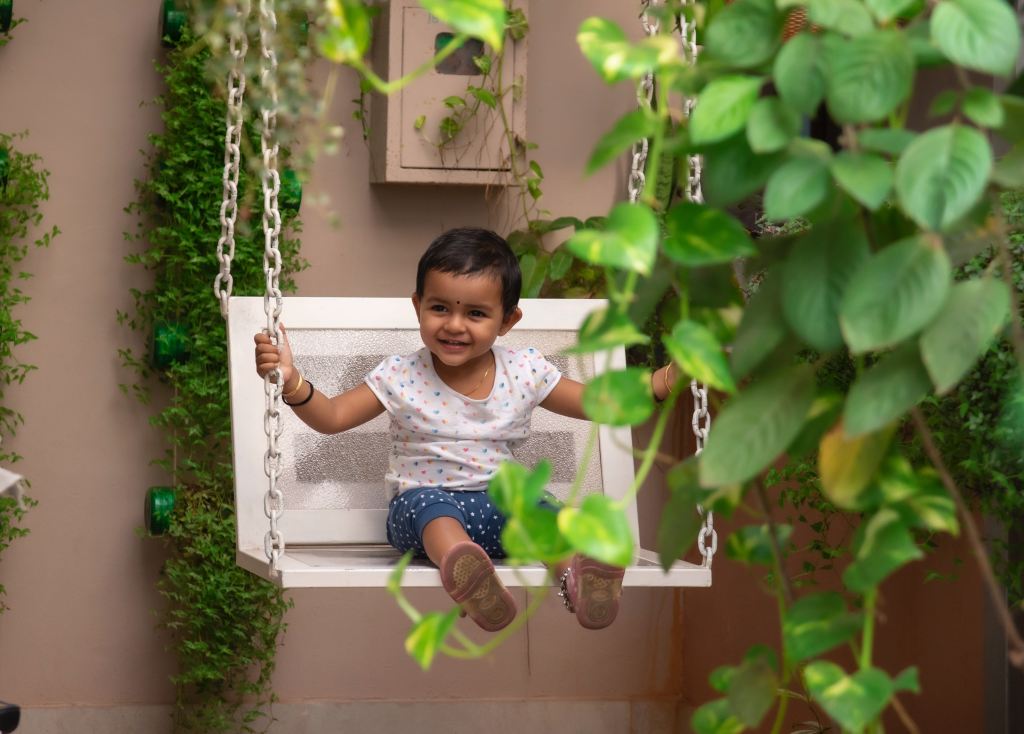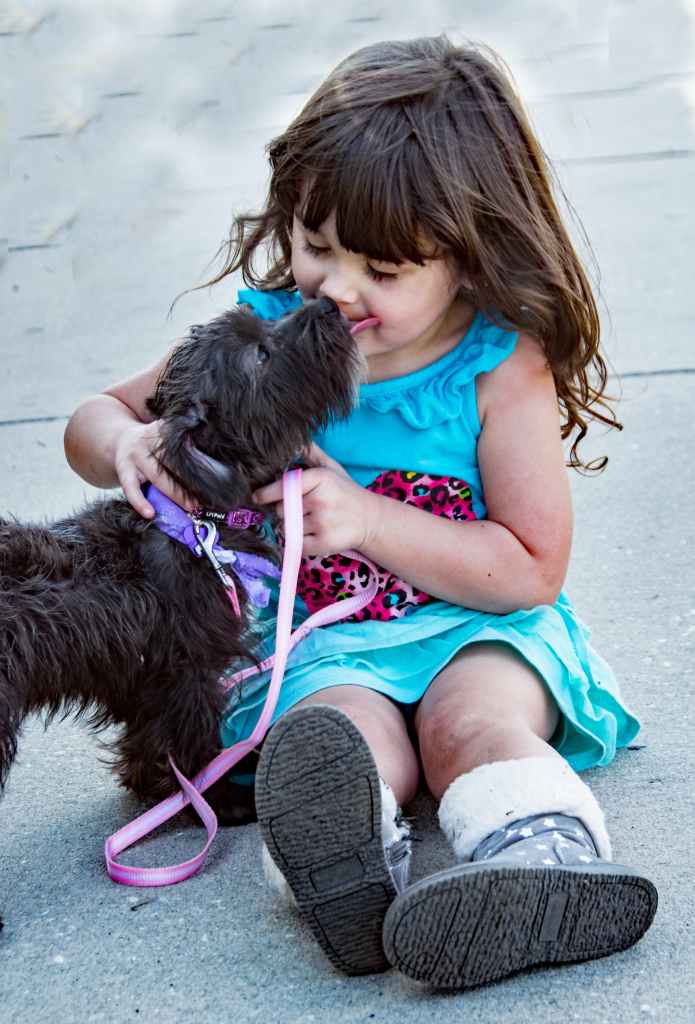Part of supporting our child’s brain development is helping them experience the world with all their senses (all 8!). As they use their senses, talking about what they are experiencing helps to reinforce the learning. Here are ideas for strengthening each sense.
Vision
One of the best things you can do for your child’s vision is to take them outside. Inside, you may only look at things that are a few feet away. Outdoors, we can look close at an ant, then at a tree, a cloud, then back down to a flower. If you stand in front of a baby as you push them on a swing, they gaze at you as you get further away, then come closer and closer. These shifts in focus build their eye muscles and reduce the chance they’ll need glasses later in life. (Genetics also plays a part.) Different types of light – rosy skies at dawn, bright light of mid-day, twilight and looking at stars at night also help with eye and vision development.

Help your child learn to track motion. For a baby, hold a toy in front of them. As they look at the toy, move it to the left then the right, then up, then down so they follow it to the edge of their peripheral vision. For older children, rolling or throwing balls helps them track motion.
Hearing
Give them lots of different things to listen to. Take music classes or get musical instruments or discover instruments around you (drum on a pot with a spoon, tap on a glass with a fork, shake a box of mac and cheese.) Sing a lot! Read to them. When they notice any sounds in the environment, talk about them – “I heard that too. That was a firetruck.” (Responsive language – noticing what your child is paying attention to and talking about it – is the best way to build your child’s language skills.)
Watch for background noise. If your TV is constantly on or there is always background music playing, it can be hard for a child to focus on and learn from any one sound.
Taste
Breastmilk (human milk) changes flavor based on what the lactating parent eats, so exposes even young babies to a variety of tastes. As food is introduced, expose your child to a wide variety of tastes. There are five flavors: sweet, salty, sour, bitter and umami, and there is the sensation of spicy hot. Children tend to greatly prefer sweet and usually aren’t fans of sour and bitter. But encourage them to sample a wide variety of flavors, and give them the words to describe those flavors and what they like about them and don’t like. (Learn about picky eaters.)

Smell
Let them experience a variety of smells. Go for walks in the woods, go to a flower garden or an herb garden. Have them in the kitchen as you cook (let them smell the spices and herbs when you open the containers) and when you gather to eat, talk about how the food smells. “When I peel the orange, you can smell it, can’t you?” Try scented playdough, scented markers and stickers. Add scents to the bath water. (More scent activities.)
Note: In our culture, we have lots of artificial scents –soaps, detergents, perfumes, air fresheners and more. Many people have chemical sensitivity and get head-achey or dizzy from all this. Consider unscented cleaning products, choose air fresheners that neutralize or eliminate odors – not just cover them up, use a Hepa filter, open windows for fresh air often.
Touch
Let them experience a wide range of sensations: playing in dirt, sand, grass, mud. Petting animals and touching different fabrics or sandpaper or bubble wrap. You can rub their back, hold their hand, give hugs, tickle, give high-fives. Let them experience being hot or being cold. Explore things hands on and talk about what they are feeling. When you get them dressed, talk about how their socks are tight and stretchy, their shirt is loose and soft. Make sensory bins for them to play in.

Some children are resistant to messy play or touching different textures. You can role model – show them how you touch those things. Give them tools to use with the item – a child who won’t just put their hands in the mud might use a shovel to scoop it or a stick to stir it and then if their hands happen to get muddy, they then play in it. Or show them how it’s OK to be messy when we’re doing messy play and we can always wash our hand when we’re done.
Vestibular system
This helps us to stay balanced, and tells us if we are moving slowly or quickly through space. This helps us stand, walk and sit up without falling over. Carry your baby in lots of positions. As they get older, encourage your child to crawl, walk, climb, run, ride, roll, jump and dance. Swing on a swing, spin on a merry-go-round. Put them on your lap and sing bounce songs. (More about the vestibular system.)
Proprioception
This is how we know where our body parts are located in space without having to look at them. Also helps us figure out how much force to use – whether picking up a fragile glass or banging on a drum. Play blindfolded games, or play games in the dark. Do lots of movement games where they stretch out, or clap, or shake their shaker soft or loud, or wrestle and rough house so they learn how much is fun and what could accidentally hurt someone. Let your child move heavy things, or carry heavy things, and handle soft or fragile things. (Learn more about proprioception – this article is specifically about supporting neurodivergent kids, but all kids benefit from proprioceptive learning.)
Interoception
Senses of our internal bodily systems –being hungry or full, itches, the need to urinate and “butterflies in our stomach” when we’re nervous are not explained by the five senses and instead indicate other ways in which we perceive information.
You can build your child’s interoceptive intelligence with these 5 steps: helping them notice, naming sensations, linking emotion to sensation, understand what happens when we ignore the sensation, and managing the situation. (“You’re wiggling your bottom. That tells me you need to pee. You’re also seeming really anxious – that happens to me when I need to pee. I’m worried that if you don’t go to the potty soon you could wet your pants. Why don’t you take a break and go to the bathroom?”)
Responding to your baby’s cues that they are full or hungry, helping them to burp when they are gassy, changing their diaper when it is wet or dirty, and noticing and talking about these sensations help them learn to listen to and respect their body’s cues. As your child gets older, we continue to talk about these things as this knowledge helps your child be more independent and helps them stay healthy. (Learn more about interoception.)
Sensory Cup
Some children are sensory seeking and can take in all the sensory input they can get. Others are easily overwhelmed. Some children might love touch, vestibular and proprioception activities, but find different tastes or too much noise overwhelming. Be sensitive to your child’s needs. Watch for disengagement cues (glazed eyes, turning away, pushing things away, muscle tension) that tell you their sensory cup is overflowing and they need a break. If you ignore those cues and keep piling on stimulus, you may face a sensory meltdown. (A “tantrum” they can’t control.)
image credits: swing Photo by Avin CP on Unsplash; high chair Photo by Vanessa Loring; dog Photo by bin Ziegler
Pingback: Reducing Sensory Bin Mess | More Good Days – Parenting Blog